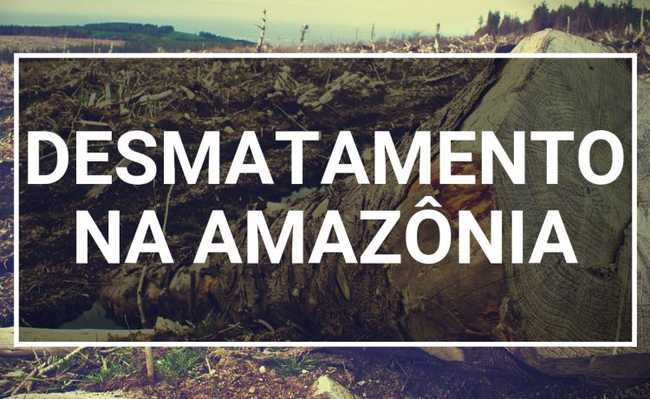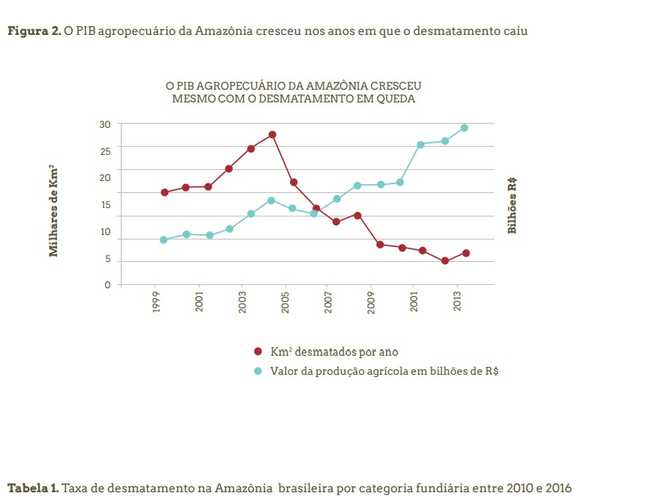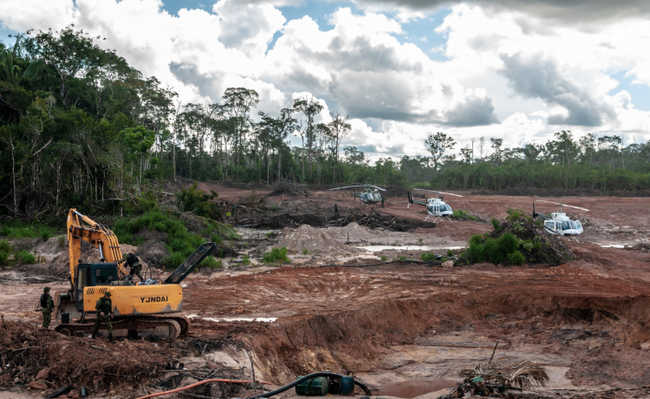Amazon deforestation: causes and how to fight it
Deforestation in the Amazon is unnecessary, it harms the development of the economy, society and the image of Brazil abroad

Deforestation in the Amazon is a matter of great concern for Brazil, as it leads to significant changes in the functioning of ecosystems, generating impacts on the structure and fertility of soils and on the hydrological cycle, constituting an important source of greenhouse gases.
- What are greenhouse gases
- Understand how the hydrological cycle works
On the other hand, zeroing deforestation in the Amazon is possible and would bring environmental and social benefits to Brazil and the world. Unlike what many people might imagine, it is feasible to quickly zero deforestation based on the experiences already developed in the country.
- What are greenhouse gases
However, deforestation in the Amazon has increased since 2012 – and is likely to continue.
- Compared to July 2018, deforestation in the Amazon rose 278% in July 2019, indicate Inpe alerts
Among the main causes of deforestation in the Amazon, we can highlight impunity for environmental crimes, setbacks in environmental policies, livestock activities, encouragement of illegal occupation of public lands and the resumption of major works. 55 million hectares were felled between 1990 and 2010, more than double that of Indonesia, which ranks second.
The pace of destruction, between 2008 and 2018, deforestation in the Amazon was 170 times faster than that recorded in the Atlantic Forest during Colonial Brazil.
The loss was accelerated between 1990 and 2000, with an average of 18,600 km² deforested per year, and between 2000 and 2010, with 19,100 km lost annually and 6 thousand km² between 2012 and 2017. About 20% of the forest The original has already been placed below without generating significant benefits for Brazilians and for the development of the region. On the contrary, the damages are manifold.
The pollution generated by fires, for example, causes deaths, an increase in cases of respiratory diseases and changes in the regional climate, which can jeopardize productivity in the field.
- What is air pollution? Know causes and types
- What is carbon neutralization?
- Deforestation in the Amazon is about to reach an irreversible limit
Without control, the deforestation rate could reach annual levels between 9,391 km² and 13,789 km² by 2027, if the same historical relationship between cattle herd and total deforested area is maintained – considering that cattle raising is one of the main drivers of deforestation in the Amazon. This can bring deforestation to an irreversible state.
Unnecessary for Brazil's growth
Deforestation in the Amazon has not turned into wealth for most Amazonians. The proof of this is that the municipalities in the Amazon are among those with the lowest HDI (Human Development Index) and IPS (Social Progress Index) in the country. They follow the so-called “boom-collapse” logic: at first, easy access to natural resources produces an explosion of wealth in the municipality. However, this wealth is concentrated in the hands of a few and runs out in a few years. The result is swollen cities with deficient infrastructure, no quality jobs and concentrated income.
The economic contribution of deforestation to the economy is minimal. The entire area deforested during the period 2007 to 2016 represented only 0.013% of the average GDP between 2007 and 2016.
The argument that deforestation in the Amazon is necessary to increase agricultural production is invalid, since there is already a huge deforested area that has been poorly used. Most are degraded pastures.
When measures against deforestation were more effective, agricultural production continued to grow, as producers invested in increasing land productivity. This can be seen in the chart below:
ten years after the Soy Moratorium – which started to block producers who planted in areas of new deforestation – the planted area went from 1.2 million hectares to 4.5 million hectares, this was due to planting in pasture areas. The large stock of underutilized areas in the region results, most of the times, from deforestation for land speculation (grilagem), through the invasion of public lands, often with the use of labor analogous to slavery.
In 2016, at least 24% of deforestation occurred in public forests that were not yet designated. This land grabbing is also linked to very low efficiency cattle raising: 65% of the deforested area in the region is occupied by pastures, with an average stocking rate of less than one head of cattle per hectare.
It is unnecessary to continue deforestation in the Amazon, since it is estimated that it is possible to house all agricultural production in areas that are already open. Several Amazon governors agree.
Measures implemented between 2005 and 2012 have dropped deforestation rates in the region by around 70% and indicate what elements are needed to achieve zero deforestation. Among them are the agreements to end deforestation through agriculture, increased livestock efficiency in areas already opened, the creation of protected areas (Conservation Units and indigenous lands) and compliance with the Forest Code. Such policies, if applied not only to the Amazon, but also to other biomes, would be capable, before 2030, of zeroing deforestation in the country.
Social and environmental losses

Diseases and deaths
Diseases and deaths caused by deforestation in the Amazon result mainly from fires.
Reducing deforestation associated with burning in the Amazon prevented 400 to 1,700 early deaths from respiratory diseases per year between 2001 and 2012 in Latin America. The drop in deforestation has reduced the rate of premature births and underweight children.
social conflicts
Until August 2017, 94,000 families were affected by land conflicts, accounting for 47 murders in the Legal Amazon.
- What is the Legal Amazon?
loss of public assets
Land grabbing reaches around 7 million hectares in the Amazon, valued at R$21.2 billion.
Trade boycott risk
Environmental campaigns led companies to establish the Soy Moratorium, which started to boycott purchases of deforested areas after 2006. France, for example, announced gradual blockades on imports of commodities that contribute to deforestation in the world, including the Amazon.
Increased climate risk
In 2016, deforestation in the Amazon was responsible for the emission of 26% of greenhouse gas emissions.
The aggravation of climate change caused by deforestation in the Amazon carries with it strong economic losses, which could lead to a reduction of 1.3% of the national GDP in 2035 and of up to 2.5% in 2050. The loss of agricultural GDP would be even more serious : between 1.7% and 2.9% in 2035 and from 2.5% to 4.5% in 2050.
How to stop deforestation in the Amazon
The end of deforestation in the Amazon basically depends on four lines of action, which include:
- Implementation of effective and permanent environmental public policies;
- Support for sustainable uses of the forest and best agricultural practices;
- Drastic market restriction for products associated with new deforestation;
- Engagement of voters, consumers and investors in efforts to eliminate deforestation.
government actions

Image: Ibama's Specialized Inspection Group (GEF) fights deforestation and cassiterite mining in the Tenharim do Igarapé Preto Indigenous Land, Amazonas; by Vinícius Mendonça Ibama, is available on Flickr
At the governmental level, some measures can be adopted to eliminate deforestation in the Amazon, such as: the end of subsidy to deforesters; increased environmental inspection; repression of land grabbing; creation of more Conservation Units; demarcation of Indigenous Lands; promotion of full and active transparency of data that help control production chains; support for sustainable forest uses and better agricultural practices; strengthening plans that increase income associated with forest conservation; creation of programs that remunerate the producer who conserves areas beyond what is required by law; increased financial transfers to municipalities and states that reduce deforestation and maintain a larger forest stock; prioritization of rural credit for municipalities that have reduced deforestation, among others.
Shares of companies and investors
Among the actions to be taken by companies and investors aimed at reducing deforestation in the Amazon, are the complete monitoring of the livestock chain, including indirect suppliers, intensifying the commitment of agreements and monitoring indirect farms of slaughterhouses; boycott of producers who deforest; demand to reduce deforestation by slaughterhouses; strengthening of production without deforestation; support to producers in environmental regularization and increased productivity; public communication of audit results and progress in implementing zero deforestation agreements; between others.
- Veganism is the most effective way to save the planet, experts say
company shares
Among the actions of society that can be adhered to to reduce deforestation in the Amazon, are the demand for the end of public subsidies to deforesters; investment and purchase of companies that prevent deforestation; support for sustainable production; demand for the protection of public lands; support for agrarian reform, demarcation of indigenous lands and campaigns against companies promoting deforestation; vote for representatives who support the creation of Conservation Units and the adoption of conscientious consumption, which includes avoiding the consumption of foods of animal origin. Learn more about this topic in the articles: "Deforestation may be on your plate" and "Reducing red meat consumption is more effective against the greenhouse effect than stopping driving".
Adapted from Zero Deforestation in the Amazon: how and why to get there and The process of deforestation in the Amazon










